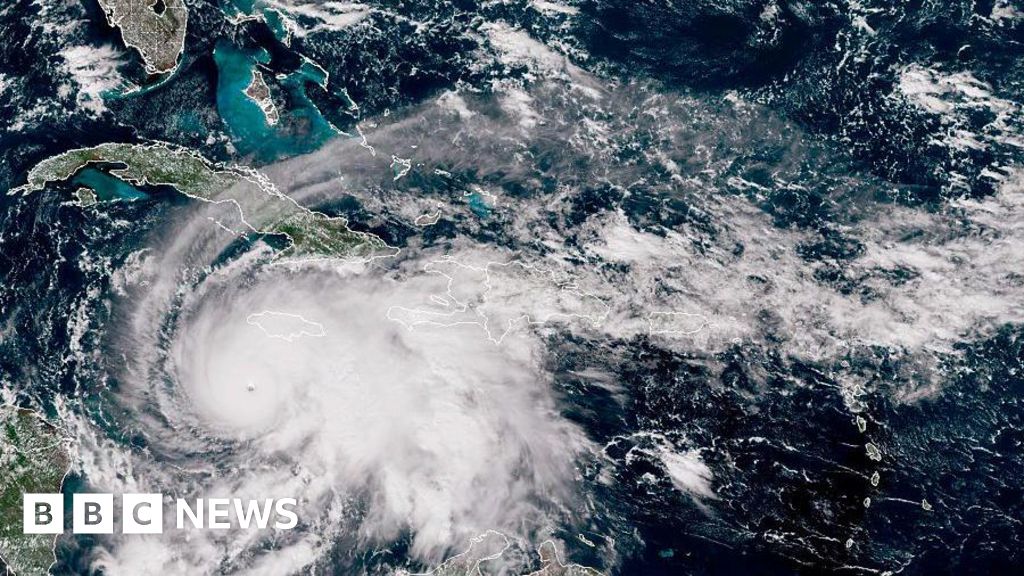Science
Hurricane Melissa Hits Jamaica: Examining Storm Intensity Trends

Hurricane Melissa, one of the strongest Atlantic storms ever recorded, has generated “extremely dangerous and life-threatening” conditions in Jamaica, as reported by the US National Hurricane Center. This storm has reignited discussions about the impact of climate change on hurricane intensity, as scientists investigate the relationship between warming oceans and storm development.
Hurricanes, also known as cyclones or typhoons in other parts of the world, form primarily over warm tropical waters. These powerful storms are characterized by high wind speeds, heavy rainfall, and storm surges that can lead to significant flooding and damage. Hurricanes are categorized based on their peak sustained wind speed, with major hurricanes classified as category three and above, reaching at least 111 mph (178 km/h).
The process of hurricane formation begins with atmospheric disturbances, such as tropical waves or areas of low pressure. As warm, moist air rises from the ocean surface, winds start to spin, influenced by the Earth’s rotation near the equator. For a hurricane to develop, sea surface temperatures typically need to be at least 27°C, and wind patterns should remain consistent with height. While the frequency of tropical cyclones globally has not increased significantly over the past century, there is evidence suggesting that a greater proportion of these storms are reaching category three or higher.
According to the Intergovernmental Panel on Climate Change (IPCC), there is “medium confidence” that average and peak rainfall rates associated with tropical cyclones have increased over recent decades. The frequency of rapid intensification events—where maximum wind speeds rise quickly—has also likely increased, posing greater risks to affected areas. For instance, Hurricane Harvey in 2017 stalled over Houston, resulting in an unprecedented 100 cm of rain within three days.
Changes in cyclone behaviour are also evident, with some studies indicating that the average location where these storms reach peak intensity has shifted poleward, potentially exposing new communities to hazards. Additionally, the increased intensity of hurricanes in the United States has been correlated with more extensive damage. Research indicates that human-driven climate change has likely intensified wind speeds by an average of 19 mph (30 km/h) for hurricanes occurring between 2019 and 2023.
Rising global temperatures also mean that warmer oceans can provide storms with more energy, leading to increased wind speeds. Moreover, a warmer atmosphere can retain more moisture, resulting in heavier rainfall. Estimates suggest that climate change made the extreme rainfall from Hurricane Harvey about three times more likely. Sea levels are also rising, primarily due to melting glaciers and the thermal expansion of water, which exacerbates flooding during storm surges.
The IPCC concludes with “high confidence” that human activity has contributed to increases in precipitation linked to tropical cyclones and “medium confidence” that human actions have raised the likelihood of tropical cyclones becoming more intense. While the overall number of tropical cyclones is not expected to rise, the IPCC asserts that as global temperatures increase, the intensity of these storms will likely rise as well.
If global temperature increases are limited to 1.5°C, the proportion of tropical cyclones reaching categories four and five may increase by around 10%. This figure could rise to 13% at a 2°C increase and up to 20% at a 4°C increase, though exact predictions remain uncertain.
As Hurricane Melissa impacts Jamaica, the ongoing research into the complex relationship between climate change and hurricane dynamics underscores the critical need for continued monitoring and adaptation strategies. Understanding these trends is vital for communities at risk, as the potential for more intense storms looms in an increasingly warming world.
-

 Health3 months ago
Health3 months agoNeurologist Warns Excessive Use of Supplements Can Harm Brain
-

 Health3 months ago
Health3 months agoFiona Phillips’ Husband Shares Heartfelt Update on Her Alzheimer’s Journey
-

 Science1 month ago
Science1 month agoBrian Cox Addresses Claims of Alien Probe in 3I/ATLAS Discovery
-

 Science1 month ago
Science1 month agoNASA Investigates Unusual Comet 3I/ATLAS; New Findings Emerge
-

 Science4 weeks ago
Science4 weeks agoScientists Examine 3I/ATLAS: Alien Artifact or Cosmic Oddity?
-

 Entertainment4 months ago
Entertainment4 months agoKerry Katona Discusses Future Baby Plans and Brian McFadden’s Wedding
-

 Science4 weeks ago
Science4 weeks agoNASA Investigates Speedy Object 3I/ATLAS, Sparking Speculation
-

 Entertainment4 months ago
Entertainment4 months agoEmmerdale Faces Tension as Dylan and April’s Lives Hang in the Balance
-

 World3 months ago
World3 months agoCole Palmer’s Cryptic Message to Kobbie Mainoo Following Loan Talks
-

 Science4 weeks ago
Science4 weeks agoNASA Scientists Explore Origins of 3I/ATLAS, a Fast-Moving Visitor
-

 Entertainment4 months ago
Entertainment4 months agoLove Island Star Toni Laite’s Mother Expresses Disappointment Over Coupling Decision
-

 Entertainment3 months ago
Entertainment3 months agoMajor Cast Changes at Coronation Street: Exits and Returns in 2025









